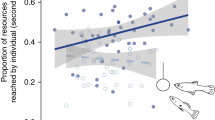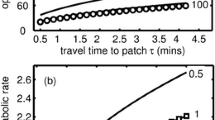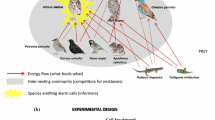Summary
The ‘information-centre’ hypothesis suggests that bird colonies function as sources of information about good feeding sites, to which unsuccessful birds may follow foragers. One assumption of the hypothesis is that unusually successful foragers are followed by other colony members when returning to a newly found, rich food source. We tested this assumption in a colony of Black-headed Gulls (Larus ridibundus). Parents feeding their young from a rich, artificial food source were observed on their return trips to the feeding site. In none of 50 cases did other colony members follow them to the newly found food. However, the gulls were attracted to groups of foraging conspecifics. In experiments with paired food piles and a group of model gulls at one pile in each pair, Black-headed Gulls always alighted first at the piles with models. Hence the information-centre mechanism was refuted, but the gulls did acquire food information from each other in another way.
Similar content being viewed by others
References
Andersson M, Götmark F (1980) Social organization and foraging ecology in the arctic skua Stercorarius parasiticus: a test of the food defendability hypothesis. Oikos 35:63–71
Burger J (1977) Role of visibility in nesting behavior of Larus gulls. J Comp Physiol Psychol 91:1347–1358
Creutz E (1963) Ernährungsweise und Aktionsradius der Lachmöve (Larus ridibundus L.). Beitr Vogelkd 9:3–58
Davis JWF (1975) Specialization in feeding location by herring gulls. J Anim Ecol 44:795–804
Drent R, Swierstra P (1977) Goose flocks and food finding: field experiments with barnacle geese (Branta leucopsis) in winter. Wildfowl 28:15–20
Emlen ST, DeMong NJ (1975) Adaptive significance of synchronized breeding in a colonial bird: a new hypothesis. Science 188:1029–1031
Erwin RM (1978) Coloniality in terns: the role of social feeding. Condor 80:211–215
Author information
Authors and Affiliations
Rights and permissions
About this article
Cite this article
Andersson, M., Götmark, F. & Wiklund, C.G. Food information in the Black-headed Gull, Larus ridibundus . Behav Ecol Sociobiol 9, 199–202 (1981). https://doi.org/10.1007/BF00302938
Received:
Accepted:
Issue Date:
DOI: https://doi.org/10.1007/BF00302938




